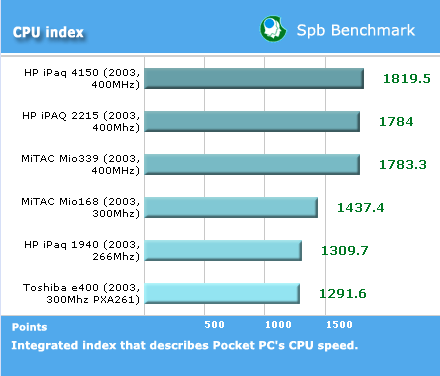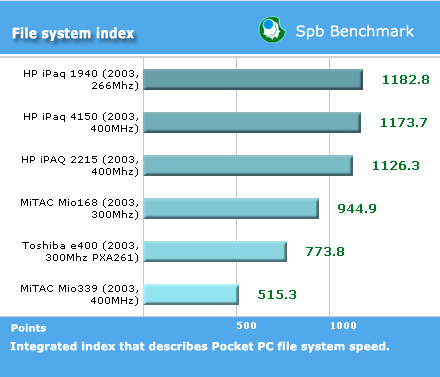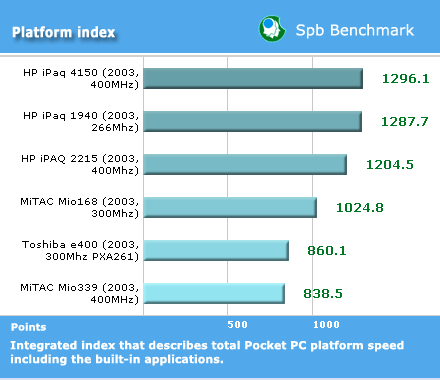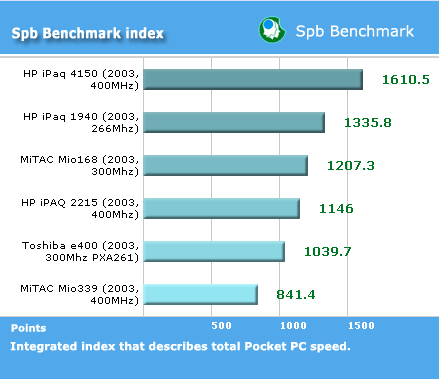|
|
Review Rover P1 (MiTAC Mio 336)
Live pictures
Package:
- PDA
- Charger
- USB synchronization cable
- Leatherette case
- 2.5 mm - 3.5 mm audio jack adapter
- Software CD
- User's guide

The new budget handheld Rover P1 is based on the MiTAC platform or the model Mio336. It's a common case with Rover models - Rover P3, Rover P3+, Rover P4, Rover P7 are also based on master platforms by the Taiwanese maker MiTAC. In this case Rover is charged with the adaptation to the Russian market including the updated localization, corresponding instruction, manual, package, service support and the distribution of the PDA in Russia under its own trademark. All hardware matters in this review are true for MiTAC Mio 336. Now both models are available on the Russian market. In its turn the Mio336 stands for a lighter version of the Mio168: it goes in a thinner casing, there is no built-in GPS-receiver, and the battery has lesser capacity. Other features remain the same. Nevertheless the Mio168 and the Mio336 refer to different groups and deserve separate reviews.
The Mio 336 comes in two color variants - the classic silver and the black-blue. In Taiwan (the home market) users prefer the black-blue version, but unfortunately in Russia you can get only the silver one, as the company doesn't plan to ship both casing versions.
The producer positions this Pocket PC for the female auditorium. However it doesn't look so - a quite usual Pocket PC form, almost classical without any gender distinctions. The company might have meant PDA small size (112.18x69.6x13.3 mm), which is even less than of HP iPaq 1940 (113.3x69.8x12.8) if not consider the thickness. Should we place these two models close by they would look almost equal taking into account the fact that iPaq's smooth lines absorb its larger size. We'd rather not consider the Mio 336 a purely women's model - it's a classic budget handheld with its cons and pros.
Let us make a lyrical digression. What can do modern budget PDA? What is their price and will it change soon? Well, an average budget Pocket PC features a small and light shell, 3.5" color TFT screen displaying 65,000 colors, poor standard kit (there is no cradle supplied), built-in accumulator and a short battery life, 300MHz processor, a single slot for extension (usually SD/MMC). They allow to playback mp3 files, watch full-length films, play colorful games, keep contacts, schedule the calendar and read books. That is a budget PDA can do everything to satisfy a modest user. However an advanced user in this case lacks wireless adapters (Bluetooth/Wi-Fi/GSM/GPRS) and the second slot for extension… At the beginning of the previous year the price for budget handhelds dramatically dropped to $300 and within the year to $230. The "classical" budget series includes such Pocket PC as Toshiba e400, iPaq 1930, MiTAC Mio339, Dell Axim X3 (the junior modification). The Pocket PC platform has some limitations which eventually involve the specification: for example the makers cannot easily set the monochrome display or remove the external dynamic, microphone or the slot (it could beat the price). They are to orient on the components cost - an expensive TFT matrix, Intel XScale processors, license fees for MS Windows Mobile… Under the current technological situation the price for the budget Pocket PC (with the same features) could descend to $170-180 should the following conditions be complied with: the world deficit for LCD-TFT matrix is overcome and prices for Intel XScale PXA270 fall gradually. Should the final cost get even lower, Microsoft would have cut the license fees for a single Windows Mobile copy thus provoking a better price for a final product. Nowadays the following trend reigns - Bluetooth and Wi-Fi penetrate the budget sector step by step transforming into a usual feature like the infrared.
Two leading Palm makers of Palm OS based PDA have reached the $220 mark from the other side: by increasing the price and multimedia opportunities, by setting high quality color screens instead of monochrome ones. The last model that Sony made monochrome was Sony SJ20 priced under $200. Now Sony's PDA line begins with Sony TJ25. The cheapest handheld from all models is Palm Zire (less than $100), anyway PalmOne gives away making monochrome screens, and Palm Zire 21 seems to be the last such model. The next model the Zire 31 enjoys the color STN screen, extension slot, program mp3-player and $150 price in the US (in Russia it costs some $220). As for the average price of budget Palm OS-driven handhelds, so it will get lower under the same factors as for Pocket PC models. The same way is true for the solutions with integrated wireless adapters (Bluetooth in Palm Zire 72, Wi-Fi in Sony TJ37). Well, let's return to our review.
The handheld perfectly fits the hand, and the plastic feels smooth and pleasant to touch. Unfortunately this model as many other models by MiTAC cannot boast about the good assembly quality: you can feel a backlash while squeezing the casing (at the turn of the top and the bottom parts). Well it resembles Rover P3. Being a tiny device it carries a little weight - just 118 g. You can bear the handheld almost everywhere, here the lace eye set at the left side looks at place. You hardly notice if it weighs anything.

Due to Rover P1 tiny dimensions and the standard-sized screen the latter seems to occupy the whole front side. Above the screen there are two LED indicators showing reminders and the charging process.
The 5 D-pad (four directions and "Enter" in the middle) didn't prove good in games: when you press "right" or any other direction the "Enter" button gets simultaneously involved. Even if switch off the middle button the situation with arcade games won't be better: the joystick is awkward, small and sometimes works incorrect. We've tested it mainly on game console emulators. However I assume it's possible to get used to it over some time. It can hardly be comparable with similar joysticks in the iPaq 1930 or especially in Dell Axim X3. The location of application buttons resembles a wing flapping and answers design purposes rather than ergonomic ones. They are placed too close to the joystick, that's inconvenient. To be fair let's mention that these control elements will do in programs, which do not require a quick reaction. To the right of the joystick there is an integrated dynamic. It is loud enough. The built-in microphone surprised with the recording quality - the words quietly pronounced in a quiet place within 2.5 m were distinctly heard in the recording. With some background noise you'll get good voice recordings within a meter. Naturally the quality received yields to that from a professional dictaphone.

The left side contains the already mentioned lace eye, round Power button, oval dictaphone button (to some extent it replaces the lacking scrolling wheel), soft reset and the audio jack. If you want to use standard headphones you'll need a hard adapter that is supplied in the standard kit (it will stick out by a couple cm). The final construction looks awkward and is uncomfortable to bear. You can find a way out with a soft adapter like that from the standard kit of HP iPaq 1940.

On the top there are the infrared port (use it to control domestic appliances within 4 meters distance), SD/MMC slot for extension and the silo. Traditionally for MiTAC the stylus is made metallic and folding.
The back panel hides the hard reset switch. At the bottom there is a communication port for synchronization and charging. Unfortunately you cannot directly charge the device, only with the USB-cable to which the AC adapter is plugged.
The screen stays standard for a budget Pocket PC: with a transflective TFT 3.5" matrix. It looks good both indoors and in direct sunlight and renders colors perfectly. The only thing that bothers is the too intensive backlight at the minimum level that doesn't provide a comfort reading in the dark.
Battery
Rover P1 comes with a non-removable Li-Ion battery (900 mAh). Our tests revealed that the handheld lasted 2 hours 20 minutes on a single charge at the maximum load (the maximum backlight, 300 MHz frequency rate, video mode). A good performance. In the mp3 mode (a forced 100 MHz frequency rate, the screen off) the handheld worked just 7 hours 30 minutes, which is quite traditional for the budget class PDA.

Productivity
This Pocket PC carries 64 MB RAM onboard, 63 MB of which is available to the user. You cannot access the nonvolatile memory, so you'd better buy a flash memory card to store large maps and "heavy' applications. Rover P1 uses a 300 MHz Intel XScale PXA255 processor. It copes well with the intended tasks (the navigation). The test results are as follows.
Traditionally we used the SPB Benchmark package to test the productivity. Our tests revealed the same figures as for MiTAC Mio168, so we'll copy this part from a corresponding review.

This index describes Pocket PC's CPU speed. The frequency rate is 25% lower than in other models, but the CPU speed descends only by 20%. It even exceeds that of Toshiba e400 running the same frequency rate (300 MHz).

The file system index describes Pocket PC file system speed (read/record/move). The main conclusion suggests that new models from MiTAC do not any longer show low file system speeds (see the results of the Mio339 and the Mio168).

The platform index describes total Pocket PC platform speed including the built-in applications. A good result lagging from the leader by 20%. You'll hardly notice the difference.

The synchronization speed is high.

Integrated Spb Benchmark index describes total Pocket PC speed. The P1 showed a very good result for the handheld powered by a 300 MHz processor.
Let's test the graphics on the PocketQuake game in the mute mode (turn the sound off by nosound 1 console command) leaving other settings on:

In the video mode we tested several clips at different intensity (kbps - kilobit per second, DivX 5.03 codec involved). Sound got encoded in mp3 format at 128kbps bitrate. We applied the criteria of dropped frames while playing, the less the better and tested a fragment from the motion picture Cats and Dogs (the fight scene). See the results:

In all, we've got expected results without a surprises or a failure.
Software
The handheld is powered by Windows Mobile 2003 for Pocket PC Premium Edition. You can learn more about the standard software included from the related review published on our site. Extra applications include only QBackup, an ordinary utility for the data backup (a selective data copying, data compression and no schedule working).
Conclusion
After the two week acquaintance with the device we call it a good budget solution worth its price (the low price in Moscow makes up $230, in Taiwan $210). It's a typical species of budget Pocket PC. The list of direct rivals includes HP iPaq 1930, Toshiba e400, Dell Axim X3 (the junior modification). There are several flaws: the lack of the scrolling wheel, uncomfortable joystick and application buttons, the casing backlash and non-standard location of the audio jack. As for the merits they are the perfect screen, low price and tiny dimensions.
If we mark all cons and pros with pluses and minuses we'll get the following matrix. We didn't pick out similar features such as the average productivity and battery life, poor standard kit.
Model/component |
Rover P1 |
Toshiba e400 |
HP iPaq 1930 |
Dell Axim X3 |
Screen |
+ |
+ |
- |
+ |
Assembly quality |
- |
+ |
+ |
+ |
Jog dial |
- |
+ |
- |
+ |
Audio jack |
- |
+ |
- |
+ |
Price* |
$ 230 |
$290 |
$230 |
$265 |
*current prices in Moscow (for May 2004)
In summer the competition in the Pocket PC sector will get tougher with the release of new models running Windows Mobile 2003 for Pocket PC Second Edition and powered by Intel XScale PXA270 (for example, Dell Axim X30 the junior modification, new budget models by HP and Fujitsu Siemens).

General features:
- Class: budget Pocket PC
- Position in the line: under Rover P4
- Rival models: HP iPaq 1930, Toshiba e400, Dell Axim X3 (the junior model)
- Operating system: Windows Mobile 2003 Premium Edition
- Processor: Intel XScale PXA255 300 MHz
- Memory: 64 MB RAM (62.82 MB available to the user)
- ROM: 32 MB (unavailable to the user)
- Connectivity: SD/MMC slot (SDIO), IrDA (SIR), USB (synchronization only)
- Display: 3,5" (active screen: 53x71 mm), 240x320 pixels, 64K colors
- Battery: non-removable Li-Ion 900 mAh
- Dimensions: 112.18x69.6x13.3 mm
- Weight: 118 g.
Anton Kotov (anton.kotov@mobile-review.com)
Translated by Anja Rytchkova (anja.rytchkova@mobile-review.com)
Published - 28 August 2005
Have something to add?! Write us... eldar@mobile-review.com
|
News:
[ 31-07 16:21 ]Sir Jony Ive: Apple Isn't In It For The Money
[ 31-07 13:34 ]Video: Nokia Designer Interviews
[ 31-07 13:10 ]RIM To Layoff 3,000 More Employees
[ 30-07 20:59 ]Video: iPhone 5 Housing Shown Off
[ 30-07 19:12 ]Android Fortunes Decline In U.S.
[ 25-07 16:18 ]Why Apple Is Suing Samsung?
[ 25-07 15:53 ]A Few Choice Quotes About Apple ... By Samsung
[ 23-07 20:25 ]Russian iOS Hacker Calls It A Day
[ 23-07 17:40 ]Video: It's Still Not Out, But Galaxy Note 10.1 Gets An Ad
[ 19-07 19:10 ]Another Loss For Nokia: $1 Billion Down In Q2
[ 19-07 17:22 ]British Judge Orders Apple To Run Ads Saying Samsung Did Not Copy Them
[ 19-07 16:57 ]iPhone 5 To Feature Nano-SIM Cards
[ 18-07 14:20 ]What The iPad Could Have Looked Like ...
[ 18-07 13:25 ]App Store Hack Is Still Going Strong Despite Apple's Best Efforts
[ 13-07 12:34 ]Infographic: The (Hypothetical) Sale Of RIM
[ 13-07 11:10 ]Video: iPhone Hacker Makes In-App Purchases Free
[ 12-07 19:50 ]iPhone 5 Images Leak Again
[ 12-07 17:51 ]Android Takes 50%+ Of U.S. And Europe
[ 11-07 16:02 ]Apple Involved In 60% Of Patent Suits
[ 11-07 13:14 ]Video: Kindle Fire Gets A Jelly Bean
Subscribe
|












